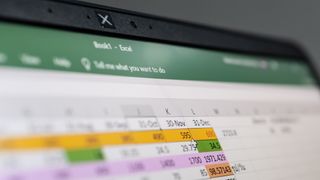How to use VLOOKUP in Excel
How to use VLOOKUP in Excel

Knowing how to use VLOOKUP in Excel tin can be extremely useful when you're dealing with huge tables. Information technology's not just like using Ctrl+F to search for a specific word or number: VLOOKUP searches a specific, user-divers range, and returns information associated with the lookup term as opposed to the term itself.
Say you need to notice the price for a certain item, or want to find out which colleague is working on a specific projection. As long as information technology'south organized by row, like any self-respecting Excel tabular array should be, VLOOKUP can find the data you need.
- See how to delete a page in Microsoft Give-and-take
- Here's how to schedule Slack messages
- How to rotate the screen in Windows 10
Using VLOOKUP does require punching in a formula, but doesn't demand skilful algebraic knowledge. To demonstrate how it works equally merely every bit possible, nosotros'll walk you through an instance where we use VLOOKUP to find out a person'southward working hours; as you lot'll see in the images, it's only a small table, simply this process works (and is intended) for much bigger tables and ranges.
At that place are also a couple of terms to become familiar with. "Lookup value" is, finer, our search term: the word, phrase or data that nosotros'll have VLOOKUP search for. "Return value" is like a search result: it'southward the data that VLOOKUP will fetch and present, having found it sorted with the lookup value by row. For VLOOKUP to piece of work, the cavalcade containing the lookup value should be to the left of the column containing the render value, so shuffle around your table if they're non in the optimal order.
How to use VLOOKUP in Excel
1. Write the lookup value in one cell, then click on an empty jail cell side by side to it.

2. In the formula bar, type "=VLOOKUP(" without spaces.

3. Click on the cell containing the lookup value you entered. Again, this should exist to the left of the empty cell you originally clicked. Note how the cell number — in our instance, A10 — now appears in the formula bar.

4. In the formula bar, type "," and so click and drag to select the cells you desire to search through. This creates the "range" within which VLOOKUP will find the data you want: the return value.

five. This is where information technology gets a bit catchy, since the procedure involves breaking with how Excel normally identifies columns with letters rather than numbers. Here, y'all demand to mentally assign numbers to each column you have highlighted in your range: in our example, we've highlighted the A and B columns, and will number then as one and ii respectively. If, hypothetically, y'all were to highlight the C, D and E columns, y'all'd number them 1, two and 3 respectively.
With the range highlighted, go along typing in the formula bar. This time, enter "," followed past the "number" of the cavalcade that'due south probable to comprise the return value. For our case, although nosotros're looking for a name that matches one in cavalcade A, what we're actually looking for is the information in cavalcade B, so we're going to type "2" afterwards the comma.

6. Blazon "," immediately followed by "False" to find an exact lucifer within the range.

vii. Press the Enter key on your keyboard, and the return value information volition appear in the cell you selected during footstep 1.

This covers how to utilize VLOOKUP on a bones level; but remember to keep your information organized then that the more easily memorable lookup value is to the left of the render value.
For more than on getting the well-nigh out of Microsoft Office apps, check out our guides on how to how to sign a Word document, how to convert a PDF to Excel and how to save a Discussion document as a PDF.
- More than: The best laptops we've tested
Source: https://www.tomsguide.com/how-to/how-to-use-vlookup-in-excel
Posted by: conleyknowded.blogspot.com


0 Response to "How to use VLOOKUP in Excel"
Post a Comment